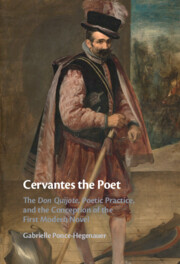 Cervantes the Poet
Cervantes the Poet Published online by Cambridge University Press: 11 May 2023
Chapter 2 treats the early Italianate-poetry that Cervantes wrote for Isabel de Valois (1567, 1568) when he was around twenty years old as serious works composed within the particular cultural and poetic practices of the Habsburg court. In his first sonnet, Cervantes’ speaker develops a conceptual play between the speaking ingenio and the lofty lady through the use of an exalted apostrophe, a key feature of Pastoral Petrarchism that would inflect the subsequent decades of the author’s literary career. The only known copy of this sonnet was preserved in an early seventeenth-century manuscript collection of pastoral and erotic lyric and narrative poetry pertaining to the Habsburg court, now housed in the Bibliothèque Nationale de France, Richelieu. This chapter examines and draws upon the manuscript in order to reconstruct the literary environment in which Cervantes wrote, as it was understood by the early modern compiler (a primary source on readership, reception, and genre). Ms. Espagnole 373 also recontextualizes the poetry that Cervantes composed the following year for the untimely death of Isabel on October 3, 1568. This chapter considers Cervantes’ relationship to Giulio Acquaviva while the papal legate was present in the Habsburg court, his journey to Rome, and the Sigura affair.
To save this book to your Kindle, first ensure [email protected] is added to your Approved Personal Document E-mail List under your Personal Document Settings on the Manage Your Content and Devices page of your Amazon account. Then enter the ‘name’ part of your Kindle email address below. Find out more about saving to your Kindle.
Note you can select to save to either the @free.kindle.com or @kindle.com variations. ‘@free.kindle.com’ emails are free but can only be saved to your device when it is connected to wi-fi. ‘@kindle.com’ emails can be delivered even when you are not connected to wi-fi, but note that service fees apply.
Find out more about the Kindle Personal Document Service.
To save content items to your account, please confirm that you agree to abide by our usage policies. If this is the first time you use this feature, you will be asked to authorise Cambridge Core to connect with your account. Find out more about saving content to Dropbox.
To save content items to your account, please confirm that you agree to abide by our usage policies. If this is the first time you use this feature, you will be asked to authorise Cambridge Core to connect with your account. Find out more about saving content to Google Drive.